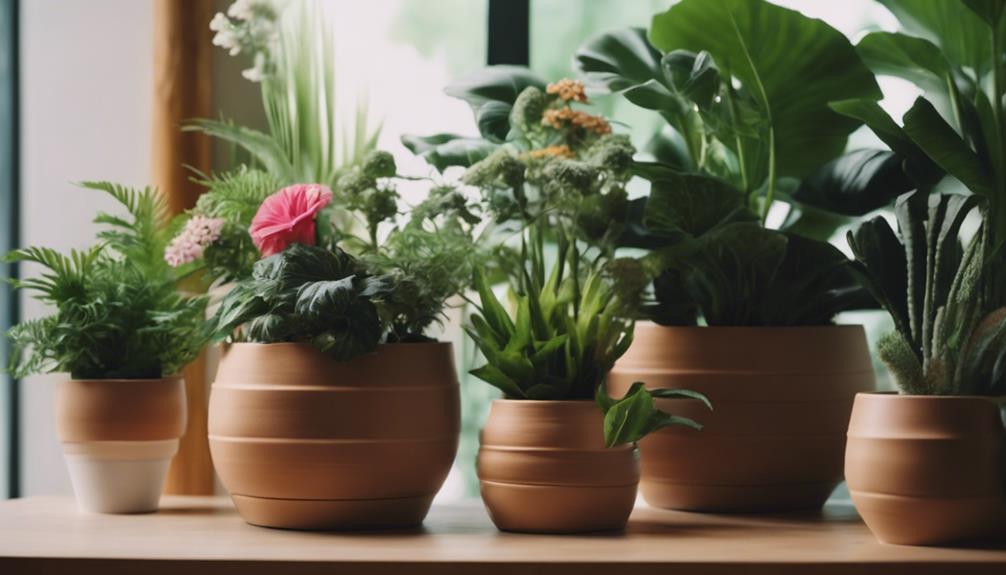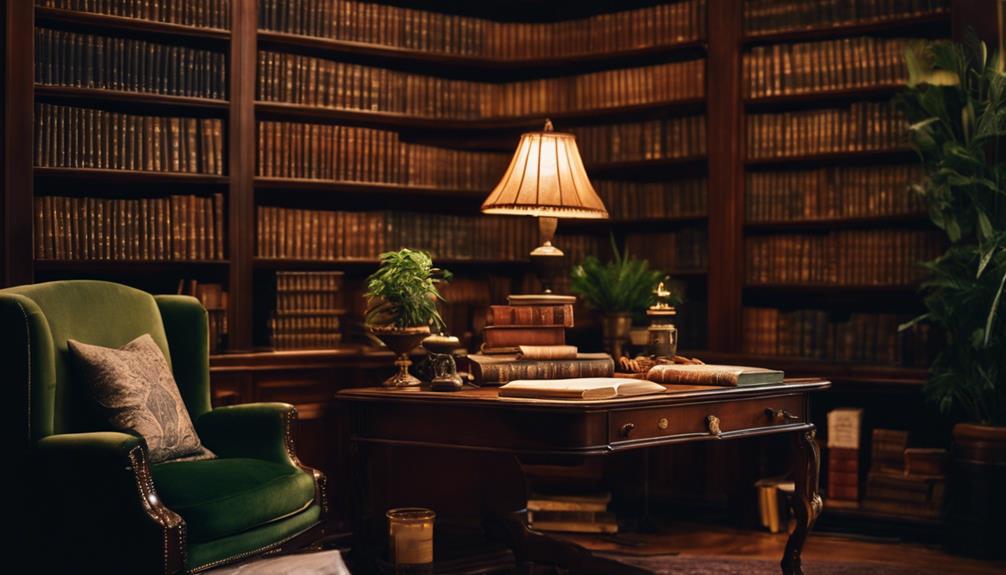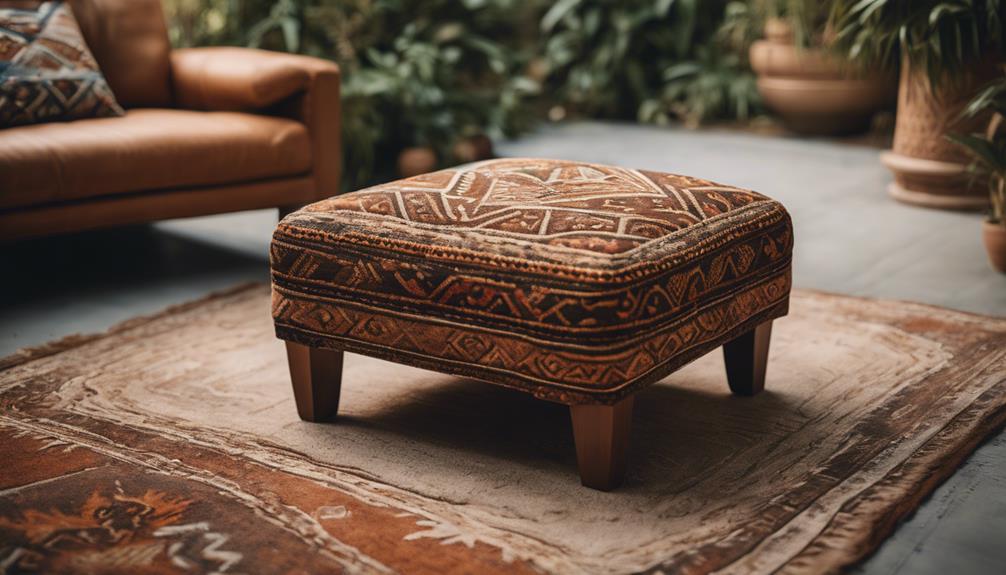Aesthetic flower pots and planters can instantly elevate your room's ambiance, adding a touch of nature that impresses everyone. Choose vibrant ceramic or rustic terracotta pots to match your style and create a cohesive color scheme. Don't forget to incorporate various textures for visual interest, like smooth ceramics paired with rugged materials. You can also enhance your display with unique plant holders and stands to showcase your greenery at different heights. By including thoughtful lighting, like pendant lights or smart LED options, you'll bring your plants, and the mood of your space, to life. You'll discover even more ideas to elevate your decor!
Key Elements

When choosing aesthetic flower pots and planters, you'll want to focus on key elements like color scheme, materials, and textures.
These aspects not only define the overall look but also influence how your plants stand out.
Color Scheme
A coordinated color scheme in your flower pots and planters can greatly enhance the visual appeal of your indoor spaces. By using complementary colors, you create striking contrasts that catch the eye, adding excitement to your decor.
For a more sophisticated look, consider a monochromatic palette, incorporating varying shades of a single color. This approach adds depth and elegance without overwhelming the room.
Don't forget to embrace seasonal colors! Bright yellows and pinks in spring, or warm oranges and reds in fall can keep your space feeling vibrant and fresh throughout the year.
When selecting your planters, make certain they reflect the existing color scheme of your room. Neutral tones work beautifully in minimalistic settings, while bold colors can complement eclectic styles, creating a cohesive environment.
Also, consider how the textures and finishes of the planters influence your color scheme. Matte ceramics can soften a space, while glossy metals can add a modern touch.
Materials
Choosing the right materials for your flower pots and planters can greatly impact both their aesthetic appeal and the health of your plants. You'll find a variety of materials to choose from, each offering unique design features. For instance, ceramic pots come in vibrant glazes, providing excellent insulation for your plant roots, while terracotta options are porous, promoting better air circulation and moisture management.
If you prefer a more modern look, metal planters made from galvanized steel or copper can be a stylish choice. Just keep in mind they may need additional drainage and insulation to protect your plants from extreme temperatures.
Don't overlook recycled composite materials, either. These eco-friendly options, crafted from recycled wood fibers or corn byproducts, combine durability with a contemporary aesthetic. They often feature unique designs that can complement your décor beautifully.
Ultimately, the materials you select will impact not just how your planters look, but also how well your plants thrive. So, consider the balance between style and functionality to create a stunning indoor garden that wows everyone!
Textures
Textures play an essential role in enhancing the aesthetic appeal of flower pots and planters, offering a range of visual and tactile experiences that can transform your indoor spaces. You can choose from smooth ceramics to rugged terracotta, each providing a unique visual and tactile experience that enhances your decor.
Incorporating various materials like galvanized metal, wood, or wicker creates dynamic contrasts that draw attention to your plant displays. Think about how ASMR textured surfaces in modern, eco-friendly planters can provide a satisfying tactile interaction while adding depth to your arrangements.
Combining different textures, such as the softness of trailing plants against the hardness of ceramic pots, captivates the eye and enriches the beauty of your indoor greenery. Additionally, using textured planters with weathered finishes or intricate patterns can serve as statement pieces, infusing character and charm into any room.
Essential Fixtures and Furniture

When it comes to enhancing your space with plants, choosing the right fixtures and furniture is key.
A hanging macramé plant holder, a vintage wooden plant stand, or a modern geometric plant stand can all elevate your decor while showcasing your favorite greenery.
Let's explore how these options can transform your home into a stylish oasis.
Hanging Macramé Plant Holder
Hanging macramé plant holders not only maximize your vertical space but also add a touch of style to any room, making them a perfect choice for plant lovers. These holders come in various designs, from minimalist to bohemian, and are typically crafted from durable cotton rope or synthetic materials. This versatility allows you to showcase different indoor plants, including succulents and trailing vines, in a way that enhances your decor.
You can easily hang macramé plant holders from ceilings, walls, or even window frames, offering plenty of creative placement options. This not only elevates the aesthetic appeal of your space but also promotes healthier plant growth by allowing ideal light exposure. When you incorporate these holders into your home, you're not just adding greenery; you're introducing a stylish element that draws the eye.
With various sizes available, you can mix and match pot sizes to create an eye-catching display. So, if you want to wow your guests and enjoy the benefits of beautiful indoor plants, consider adding hanging macramé plant holders to your decor. They'll make your space feel vibrant and inviting!
Vintage Wooden Plant Stand
A vintage wooden plant stand not only elevates your plants but also adds a classic touch to your decor, making it a perfect complement to your hanging macramé plant holders. These stands showcase your greenery at varying heights, creating visual interest and depth in your space. Crafted from durable hardwoods, a vintage wooden plant stand guarantees long-lasting quality and stability, supporting various planters and pots without worry.
The intricate craftsmanship and unique designs of these stands make them functional yet stylish decorative pieces. Their natural wood finish seamlessly blends with a wide range of interior styles, whether you lean towards rustic, farmhouse, modern, or bohemian aesthetics. By incorporating a vintage wooden plant stand, you enhance the overall ambiance of your room.
Many of these stands come with multiple tiers or shelves, allowing you to display several plants together. This arrangement not only maximizes your space but also creates a beautiful focal point that captures attention. So, if you want to wow your guests with an inviting, nature-inspired atmosphere, a vintage wooden plant stand is an ideal choice.
Modern Geometric Plant Stand
Modern geometric plant stands offer a striking blend of style and functionality, elevating your greenery while enhancing your decor. These stands come in a variety of materials, such as metal and wood, allowing you to choose one that perfectly fits your aesthetic. Their unique shapes—think triangles, hexagons, and cuboids—create a visually enchanting display for your plants at varying heights, making them a focal point in any room.
Designed to support multiple pots, a modern geometric plant stand is practical and versatile, enabling you to showcase a diverse range of plants. The open design promotes air circulation, ensuring your plants thrive while adding an inviting touch to your space. Some stands even feature built-in drainage solutions, preventing water accumulation and protecting your surfaces from damage.
When you incorporate a modern geometric plant stand into your home, you're not just displaying plants; you're making a statement. These innovative stands effortlessly combine artistry and practicality, allowing you to express your personal style while nurturing your love for nature.
Lighting Ideas
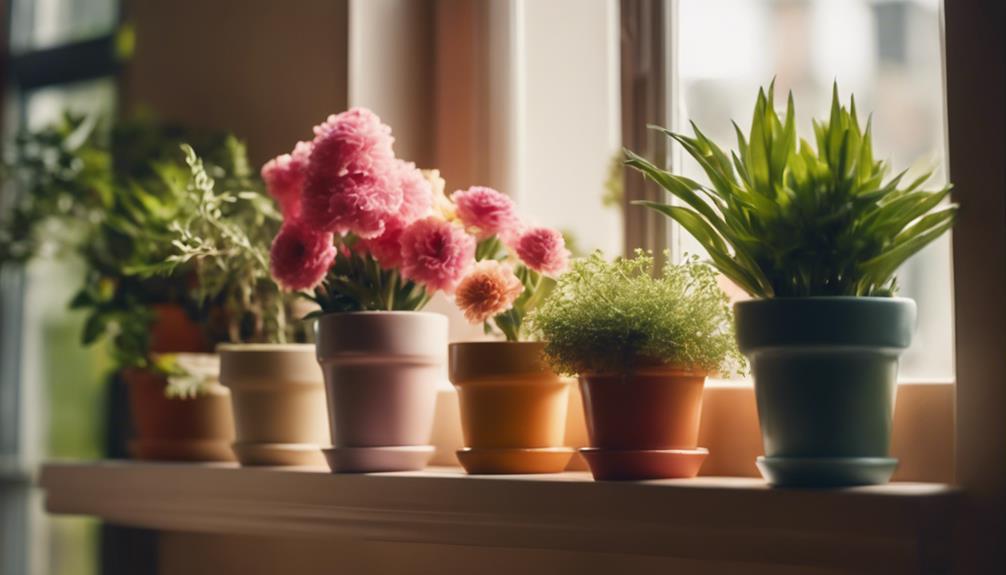
When it comes to showcasing your flower pots and planters, lighting plays an essential role.
You can enhance their beauty with pendant lights that feature plant motifs, or let natural light flood in through skylights.
Consider adding recessed LED spotlights or soft ambient floor lamps to create a warm and inviting atmosphere for your indoor garden.
Pendant Lights With Plant Motifs
Pendant lights with plant motifs elevate your indoor spaces by infusing a natural aesthetic that beautifully blends illumination and nature. These fixtures feature designs inspired by leaves, flowers, and vines, bringing a touch of natural beauty into your home. When you choose pendant lights that incorporate these motifs, you create a unique focal point that draws attention and enhances the overall ambiance of any room.
Available in various styles like bohemian, modern, and rustic, these lights allow you to express your personal taste while maintaining that botanical touch. Many options are made from eco-friendly materials, such as recycled metals or sustainably sourced wood, which aligns perfectly with the growing trend of sustainability in home decor.
Not only do these pendant lights provide ambient lighting, but they also create a calming atmosphere, evoking feelings of tranquility and connection to the outdoors. Whether you hang them in your living area, kitchen, or dining space, they'll transform your environment into a serene oasis that wows everyone who enters.
Embrace the beauty of nature indoors and let pendant lights with plant motifs illuminate your life!
Natural Light From Skylights
Skylights flood your space with natural light, creating an inviting atmosphere that benefits both you and your indoor plants. With up to 30% more daylight than traditional windows, skylights greatly enhance the conditions for your plants.
The angle and placement of these openings distribute light evenly, mimicking the natural habitats of various plant types. This makes it easier for you to grow a diverse range of indoor greenery, including tropical plants that thrive in bright conditions.
Beyond aesthetics, natural light from skylights means you can reduce your reliance on artificial lighting, which not only lowers energy costs but also promotes a healthier indoor environment. The enhanced light levels allow your plants to flourish, adding vibrant life to your rooms.
Plus, skylights can improve ventilation, helping to maintain humidity levels that are ideal for your plants' health.
Recessed LED Plant Spotlights
To complement the natural light from skylights, recessed LED plant spotlights offer a focused lighting solution that enhances indoor plant growth with the specific light spectrum they need.
These spotlights provide the ideal conditions for photosynthesis, ensuring your plants thrive. Plus, they're energy-efficient, using considerably less power compared to traditional lighting options, which helps reduce your electricity bills over time.
One of the great features of recessed LED plant spotlights is their adjustable brightness settings. This allows you to customize the light intensity based on your plants' specific needs, creating the perfect environment for growth.
Installation is a breeze, and these fixtures blend seamlessly into your home decor, providing a sleek and modern aesthetic that highlights the beauty of your houseplants.
With a long lifespan—lasting 25,000 hours or more—these fixtures reduce the need for frequent replacements and maintenance.
So, not only do recessed LED plant spotlights enhance your indoor garden, but they also add a stylish touch to your living space.
Invest in these innovative lighting solutions, and watch your plants flourish while elevating your home decor.
Soft Ambient Floor Lamps
Enhancing your living space with soft ambient floor lamps creates a warm and inviting atmosphere that beautifully showcases your indoor plants and flower pots. These lamps not only provide functional lighting but also bring life to your decor, transforming any room into a cozy sanctuary.
With various styles, materials, and colors available, you can easily find a floor lamp that complements your existing decor while accentuating your favorite flower arrangements.
Many soft ambient floor lamps come with adjustable brightness levels, allowing you to customize the light intensity to match your mood or activity. Whether you want a gentle glow for relaxation or brighter light for reading, these lamps cater to your needs. Plus, LED options are energy-efficient, consuming up to 75% less energy than traditional bulbs and lasting longer, which means less hassle with replacements.
When you position a soft ambient floor lamp near your plants, the diffused light highlights their colors and textures, creating stunning visual impact. This subtle illumination not only enhances the beauty of your botanical collection but also enriches the overall aesthetic of your living space.
Decorative Elements
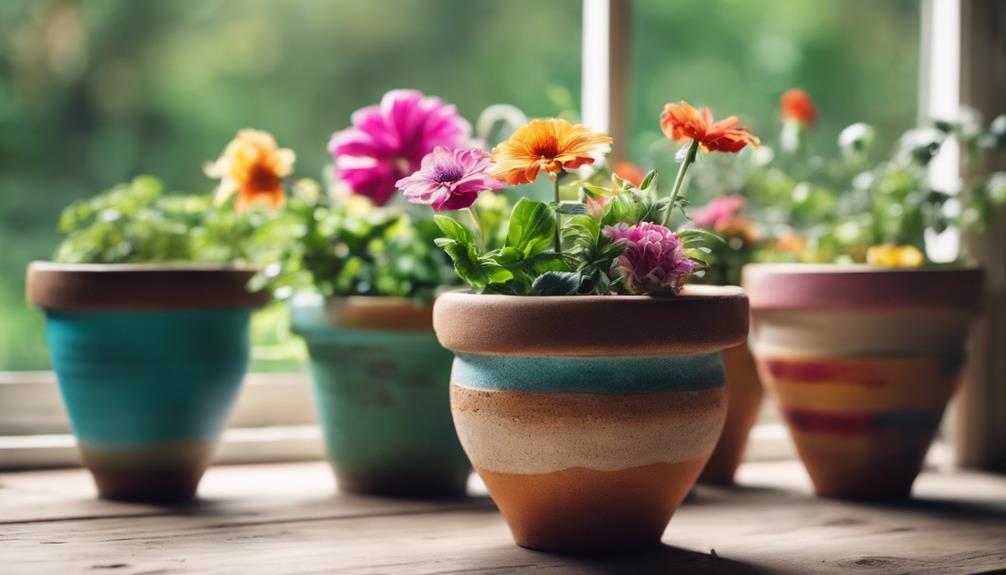
When you think about enhancing your space, consider adding decorative elements like hanging terrariums with fairy lights. They not only bring a touch of whimsy but also create a magical ambiance.
Pair them with botanical wall art and a plant-themed wall clock to tie your decor together beautifully.
Hanging Terrarium With Fairy Lights
A hanging terrarium with fairy lights transforms your space into a magical haven, blending the charm of live plants with a warm, inviting glow. This unique decor piece not only showcases beautiful greenery but also enhances your room's ambiance with its enchanting illumination.
You can customize your terrarium with various plant types, like succulents or air plants, which thrive in the contained environment and require minimal maintenance. The soft light from the fairy lights creates a cozy atmosphere, making these hanging terrariums perfect for bedrooms, living rooms, or as a unique centerpiece for gatherings.
When you incorporate fairy lights, you're not just adding a decorative touch; you're also highlighting the plants' textures and colors, turning your terrarium into a dynamic focal point. Many hanging terrarium kits come with everything you need, including glass containers, decorative stones, and, of course, fairy lights.
This simplifies the setup process, especially for beginners. With a little creativity, you can create a stunning display that wows your guests and brings a touch of nature indoors, perfectly marrying aesthetics with functionality.
Botanical Wall Art
Transforming your space with botanical wall art adds a vibrant touch that complements the enchanting atmosphere created by hanging terrariums.
By incorporating real or artificial plants into decorative frames, you create a unique fusion of nature and home decor that elevates any room's aesthetic. Framed plant displays, often crafted in shadow boxes, allow you to present various botanical specimens creatively, turning them into eye-catching art pieces.
You can also explore living wall displays that utilize vertical space, purifying indoor air while enhancing your decor with dynamic visuals. Wall-mounted planters are another fantastic option, as they add texture and dimension to flat surfaces, allowing trailing plants to cascade down and create an engaging effect.
One of the best aspects of botanical wall art is its versatility; you can easily update seasonal arrangements to refresh your decor throughout the year. Whether you're opting for a lush green look or a more subdued palette, botanical wall art offers endless possibilities for personalization.
With these decorative elements, you'll not only beautify your space but also infuse it with the life and energy of nature.
Ceramic Plant-Themed Wall Clock
Ceramic plant-themed wall clocks not only keep you on schedule but also infuse your space with vibrant botanical charm. These clocks blend functionality with decorative appeal, making them an attractive addition to any room's decor. Often featuring bright colors and intricate plant designs, they complement various aesthetics and elevate your interior ambiance.
The durability of ceramic guarantees that these clocks maintain their beauty over time, while their smooth surface makes them easy to clean. You'll enjoy how they effortlessly enhance the design elements of your space. Many models come equipped with silent movements, allowing you to create a peaceful environment free from the ticking noise of traditional clocks.
Integrating a plant-themed wall clock into your decor helps create a cohesive look that celebrates nature. It adds a whimsical touch to your room, making it an eye-catching focal point. Whether you place it in your living room, kitchen, or home office, this decorative element serves as a reminder of the beauty of the natural world.
Flooring
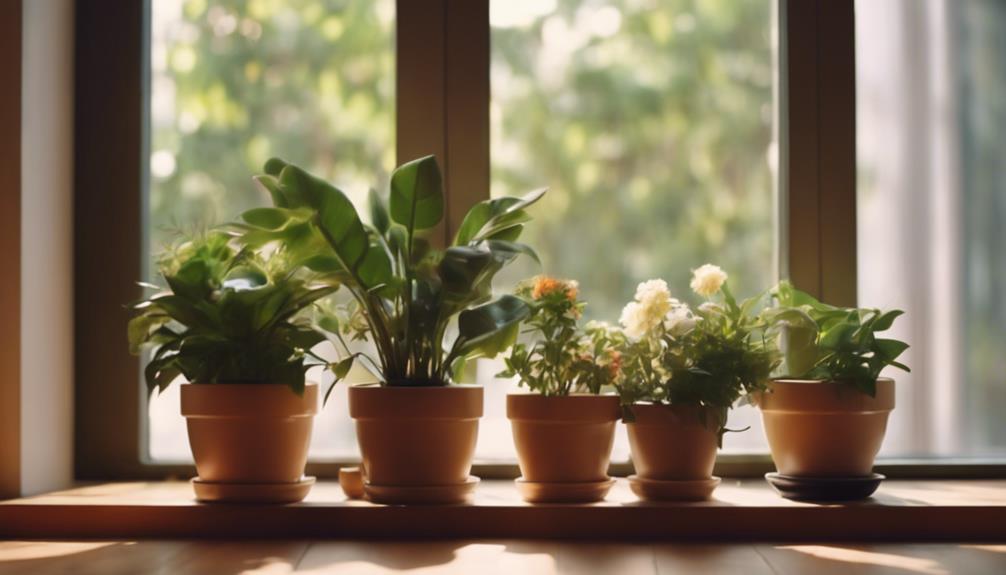
When choosing flooring, think about how different materials can enhance your space's aesthetic.
Bamboo laminate offers eco-friendly warmth, while cork flooring provides natural insulation that feels great underfoot.
If you're after rustic charm, reclaimed wood can beautifully complement your flower pots and planters.
Bamboo Laminate for Eco-Friendly Warmth
Bamboo laminate flooring brings eco-friendly warmth to your home with its sustainable materials and modern aesthetics. Made from rapidly growing bamboo grass, it's harvested every 3-5 years, making it a unique choice for environmentally conscious homeowners. This flooring option not only looks stunning but also aligns with your values.
You'll appreciate that bamboo laminate typically involves fewer chemicals in its manufacturing process compared to traditional hardwood floors, resulting in a lower environmental impact. With a hardness rating comparable to maple, bamboo laminate is incredibly durable, making it perfect for high-traffic areas in your home.
The variety of styles and finishes available means you can easily find a design that complements your decor while providing a unique, contemporary touch.
Plus, the installation process is a breeze; you can often install bamboo laminate directly over existing floors using a click-lock system, saving you time and effort.
Cork Flooring for Natural Insulation
After exploring the benefits of bamboo laminate, consider cork flooring as another eco-friendly option that provides excellent natural insulation for your home.
Made from the bark of cork oak trees, this flooring is sustainably harvested every 9 to 12 years, making it a responsible choice for your space. Its unique cellular structure grants cork flooring impressive thermal resistance, helping maintain a consistent indoor temperature and reducing energy costs.
Cork flooring's natural insulation properties, with a thermal resistance of approximately 0.042 to 0.065 W/mK, outperform many traditional flooring materials. Plus, its sound-absorbing capabilities can reduce noise levels by up to 50%, creating a quieter and more serene environment in your home. This is perfect if you want to enhance your living space without sacrificing comfort.
Additionally, cork is hypoallergenic and resistant to mold and mildew, ensuring a healthier atmosphere for you and your loved ones. When you choose cork flooring, you not only add a touch of nature to your home but also create a warm and inviting space that everyone will admire.
Embrace this natural flooring option for a cozy and stylish living area!
Reclaimed Wood for Rustic Charm
Embracing reclaimed wood flooring instantly adds rustic charm and character to your home, showcasing the unique history of each piece. When you choose reclaimed wood, you're not just selecting a beautiful flooring option; you're also making an eco-friendly choice. This type of flooring repurposes old timber, which reduces waste and minimizes the need for new lumber.
Each plank tells a story with its distinctive grain patterns, knots, and weathered textures, making your space more visually interesting. Plus, reclaimed wood typically contains fewer volatile organic compounds (VOCs) than newly manufactured options, enhancing your indoor air quality.
While the cost of reclaimed wood flooring can vary, it often proves to be a more sustainable choice compared to traditional hardwoods, appealing to environmentally conscious homeowners. Just keep in mind that installing reclaimed wood may require special techniques or adhesives to guarantee stability and longevity, especially since older materials might've natural wear and tear.
Conclusion
Incorporating aesthetic flower pots and planters into your space can truly transform your room.
With the right fixtures, lighting, and decorative elements, you can create a vibrant atmosphere that showcases your love for nature.
Don't underestimate the power of flooring, either—it can tie your whole design together.
So go ahead, get creative, and let those plants shine!
You'll not only wow your guests but also enjoy a revitalizing and invigorating environment every day.
